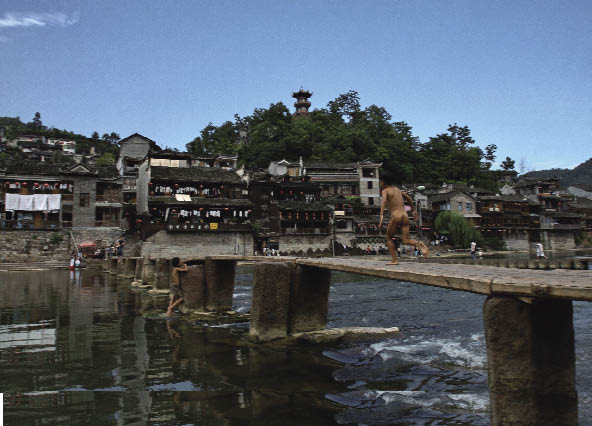Contemporary Life in an Ancient Town
By staff reporter LI YAHONG
Contemporary Life in an Ancient Town
By staff reporter LI YAHONG
Furong is a small town in western Hunan Province with a history of more than 2,000 years. Two decades ago it was called Wangcun, or King's Village, because it was once the home of a local tribal king of the Tujia (one of China's 56 ethnic groups). In 1986, it became the shooting location for the blockbuster film Hibiscus Town. Ever since the formerly quiet, unknown village of Wangcun has been known as Hibiscus Town and has bustled with swarms of visitors.
 |
| The Tuojiang River is still the major source of amusement for Fenghuang's Children. |
Tang Zhaohui, clad in a checkered blue shirt and black cloth shoes, is a spare man in his 40s. He was born in this ancient Tujia village, which sits against a hill and is surrounded by water on three sides. A stone path traverses the rising slope, forming the town's main thoroughfare. On either side sit local plank houses with tiled roofs. I peeped into one house and saw a dark room scattered with sacks of grain, dirty clothes, and pots and pans.
Some of the houses date from the 18th century. Their backs are propped up by logs and are suspended over a river, while the fronts face the town's central stone path. Most of the front rooms have been converted into shops, hung with cured fish and pork and assortments of Tujia garments, ornaments and cultural relics.
Old villagers still wear embroidered blue Tujia costumes. Some sit or squat by their gates, looking blankly at passing tourists, or eating from big bowls of rice. Now and then villagers carrying bamboo baskets on their backs walk past wandering visitors. They present a sight usually associated with village scenes from decades ago.
Over the past 30 years of reform and opening-up, many traditional dwellings have been pulled down to make way for a modern lifestyle that the Chinese people have long admired and desired. Fortunately, some out-of-the-way and economically backward villages have survived. "The rapid development of tourism in recent years has helped protect some old and characteristic villages like Hibiscus Town," said our tour guide Shi Mei.